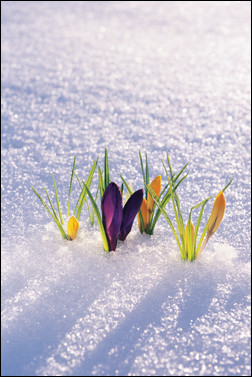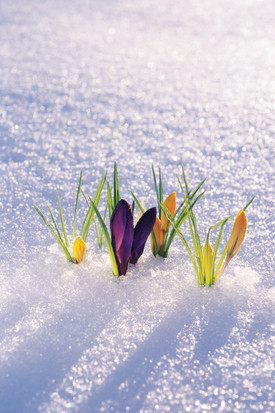Autumn is a time to prepare beds and planters for winter’s rest, but it is a time of anticipation, as well, thanks to flower bulbs. Fall-planted bulbs—beloved harbingers of spring—let gardeners dream of warm days, many months ahead.
General Bulb-Planting Tips
Winter’s chill triggers growth of fall-planted bulbs, so be sure to establish your bulbs in containers and sunny, well-drained spots in the garden about six to eight weeks before the first hard frost. As bulbs are easily confused with one
 |
another, keep them in original packaging until popping them in the ground. Dig fairly large holes and loosen soil around the sides of the holes; this provides good drainage and encourages healthy, thick root development. (You can add a bit of compost, peat moss or sand to the soil to promote drainage, as well). Once frost has settled in, cover bulbs with a blanket of mulch to protect them from the cold and provide consistent temperatures through the winter. Remove the mulch when spring arrives.
Plan before Planting
Before you plant your bulbs, envision how the blooms will fit into your gardening plan and make decisions about types, positioning and spacing. Unless you absolutely adore a particular sort and color of bulb, consider selecting early-, middle- and late-blooming bulbs to enjoy throughout the season. Plant taller bulbs behind smaller (or in the middle of a garden that can be viewed from all sides). Because bulb foliage must be allowed to fade naturally rather than being cut back, mix bulbs with perennials to provide extra interest while hiding withering greenery.
Plant Each Bulb with Care
Reading accompanying instructions is essential when planting bulbs. Note the specific depth required for a particular bulb and, using your bulb planter or trowel (or a spade, for bulb clusters), dig the hole, set the bulb in place (pointy tip facing up, roots facing down), cover loosely with soil and water well. Generally, a bulb’s planting depth is about three times its width, so larger bulbs (alliums, daffodils and tulips) are set deeper in the soil than are smaller bulbs, such as snowdrops and English bluebells. Aim to establish large bulbs about three or more inches apart and small bulbs one to two inches apart.
Let Your Imagination Go
Allow your creativity to flow when planting bulbs. Bulbs are lovely planted in formal rows but can create a different and equally beautiful effect in large, irregular, natural-looking clusters of 40 or 50 (or more). Consider planting numerous types of bulbs together (either bulbs that flower at the same time or at different times). And remember, bulbs don’t only belong in the garden. Why not plant bunches of tiny crocuses throughout your lawn for a meadow-like effect? Bulbs are charming in containers, as well. Imagine a wash of alliums in pots along the front walkway, tulips and hyacinths in clustered stone or large plastic planters on your back patio, a stand of scilla in your window box. While traditional favorites are lovely and familiar friends every spring, consider adding a new and unusual bulb to your garden repertoire each year.
Always be Planning Ahead
In your garden diary, note where you planted each type of bulb. In spring, once blooms appear, photograph bulbs and tuck the photos in your diary (or store them on your computer) as a guide for next fall when fall-bulb-planting season comes around again. Always buy bulbs early so you don’t miss your favorites, and choose bulbs that will bloom alongside other flowering plants, shrubs or trees. When you can, buy bulbs in bulk as a cost-saver. Why not buy in bulk with bulb-loving friends? Gardening with friends often leads to new botanical discoveries.
The chill of autumn reminds us of the wintry days to come, but planting flower bulbs on a crisp, sunny autumn day lets us dream of and anticipate warm spring days to come and gives us a start on our spring gardens, as well.
About the Author
Scott Gray is a garden enthusiast and freelance writer, currently consulting for All Garden Planters; a company that provides plastic planters, ceramic pots and planters, and other types of decorative planters.
Credit: Renovate Your World




























